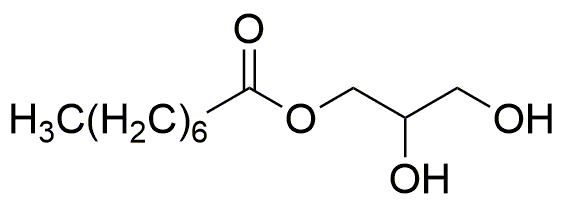Monocaprylin is widely utilized in research focused on:
- Food Industry: As an emulsifier and preservative, it enhances the texture and shelf life of various food products, making it ideal for baked goods and dairy items.
- Cosmetics and Personal Care: Its moisturizing properties make it a popular ingredient in creams and lotions, providing skin hydration and improving product stability.
- Pharmaceuticals: Used as a solubilizing agent for poorly soluble drugs, it helps improve bioavailability, allowing for more effective medication formulations.
- Animal Nutrition: Acts as a feed additive that promotes gut health and enhances nutrient absorption in livestock, contributing to better growth rates and overall health.
- Biotechnology: In cell culture applications, it serves as a surfactant that aids in the growth of cells, making it essential for research in tissue engineering and regenerative medicine.
General Information
Properties
Safety and Regulations
Applications
Monocaprylin is widely utilized in research focused on:
- Food Industry: As an emulsifier and preservative, it enhances the texture and shelf life of various food products, making it ideal for baked goods and dairy items.
- Cosmetics and Personal Care: Its moisturizing properties make it a popular ingredient in creams and lotions, providing skin hydration and improving product stability.
- Pharmaceuticals: Used as a solubilizing agent for poorly soluble drugs, it helps improve bioavailability, allowing for more effective medication formulations.
- Animal Nutrition: Acts as a feed additive that promotes gut health and enhances nutrient absorption in livestock, contributing to better growth rates and overall health.
- Biotechnology: In cell culture applications, it serves as a surfactant that aids in the growth of cells, making it essential for research in tissue engineering and regenerative medicine.
Documents
Safety Data Sheets (SDS)
The SDS provides comprehensive safety information on handling, storage, and disposal of the product.
Product Specification (PS)
The PS provides a comprehensive breakdown of the product’s properties, including chemical composition, physical state, purity, and storage requirements. It also details acceptable quality ranges and the product's intended applications.
Certificates of Analysis (COA)
Search for Certificates of Analysis (COA) by entering the products Lot Number. Lot and Batch Numbers can be found on a product’s label following the words ‘Lot’ or ‘Batch’.
*Catalog Number
*Lot Number
Certificates Of Origin (COO)
This COO confirms the country where the product was manufactured, and also details the materials and components used in it and whether it is derived from natural, synthetic, or other specific sources. This certificate may be required for customs, trade, and regulatory compliance.
*Catalog Number
*Lot Number
Safety Data Sheets (SDS)
The SDS provides comprehensive safety information on handling, storage, and disposal of the product.
DownloadProduct Specification (PS)
The PS provides a comprehensive breakdown of the product’s properties, including chemical composition, physical state, purity, and storage requirements. It also details acceptable quality ranges and the product's intended applications.
DownloadCertificates of Analysis (COA)
Search for Certificates of Analysis (COA) by entering the products Lot Number. Lot and Batch Numbers can be found on a product’s label following the words ‘Lot’ or ‘Batch’.
*Catalog Number
*Lot Number
Certificates Of Origin (COO)
This COO confirms the country where the product was manufactured, and also details the materials and components used in it and whether it is derived from natural, synthetic, or other specific sources. This certificate may be required for customs, trade, and regulatory compliance.

